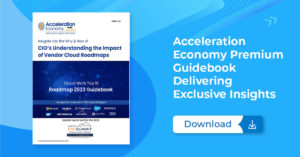
By now, you’re probably used to hearing about skyrocketing cloud spending costs. There are lots of tales, like how Adobe lost $80,000 a day due to unplanned charges. Or how an entrepreneur encountered a surprise $11,000 Azure bill. Or, consider the $42,000 monthly bill Elon Musk recently instigated for Twitter applied programming interface (API) access. These sorts of fees suddenly appear on the balance sheet, often to the chagrin of cloud-aware financial officers.
FinOps has dominated recent discussions of possible counters to escalating cloud spending in a leaner tech climate. What is FinOps? It’s the practice of optimizing cloud resources to reduce overall spending. Lately, headway has been made to standardize both the practice of FinOps as well as data formats to help bring transparency to cloud spending data. FinOps is a helpful concept for reducing waste, but is it working in practice?
The Goals of FinOps
Before I answer that question, let’s consider FinOps’s aims in more detail. The FinOps Foundation, a Linux Foundation project, describes FinOps as “an evolving cloud financial management discipline and cultural practice that enables organizations to get maximum business value by helping engineering, finance, technology, and business teams to collaborate on data-driven spending decisions.”
The FinOps discipline can involve a few key actions, like critically analyzing cloud computing and right-sizing workloads. The FinOps Framework, an operating model for FinOps, organizes these capabilities into six core domains:
- Understanding cloud costs and usage
- Performance tracking and benchmarking
- Real-time decision-making
- Cloud rate consumption
- Cloud usage optimization
- Aligning the organization around FinOps principles
FinOps is typically enacted in conjunction with cost management tools like AWS Cost Explorer, Cloudablity, CloudHealth, Azure Cost Management, or even homegrown applications. The “State of FinOps 2022” report found that teams use an average of 3.7 tools to enact FinOps.
So, Is FinOps Panning Out?
The answer, unfortunately, is a big “not yet.” The excitement is definitely there, but gains from FinOps have been elusive. In fact, according to a recent report from CloudBolt Software, “The REAL State of FinOps,” only one respondent out of the 500 surveyed said they had realized a positive material impact from FinOps to date. Although 82% of companies now have a formal FinOps team in place, nearly all organizations are still waiting for FinOps strategies to pan out. So, why is this?
Well, Kyle Campos, CloudBolt CTO, attributes this situation possibly to a high degree of siloed knowledge or awareness in enterprises about the fundamental issues, totally blocking the required measurements and actions from taking place. Or, it could be enterprise bureaucracy holding back the rollout of FinOps initiatives. Worse, it might be an unhealthy combination of both.
“I was as shocked as anyone,” explained Campos, referring to the results of the CloudBolt report. “A commonly understood reality is that there’s an initial round of so-called ‘low-hanging fruit’ that should be within short reach if you are embarking on a FinOps journey with any degree of seriousness.”
Another reason is that FinOps could be in a trough of disillusionment, similar to the early days of DevOps, explained Jaret Chiles, Chief Services Officer with DoiT International. Integrating FinOps methodologies requires more than just tooling — it requires a cultural adjustment, he said, and investments that hinge on cultural change take time to realize.
“FinOps is a style of management that requires time, investment, and collaboration,” said Chiles. It involves drawing operational roadmaps, decision-making, and deep data insights closer to financial teams, and it requires feeding reliable and timely data on usage to FinOps leaders, who then use that information to constantly reshape strategy.”
Other people working in the FinOps space are more skeptical about the CloudBolt survey results. “Statements in that survey just don’t align with reality,” said J.R. Storment, executive director of the FinOps Foundation. He suggests that it may have been an issue with the polling base, an awkward line of questioning, or a combination of both factors that produced the click-bait headline.
“FinOps has moved up into a board-level concern with companies that have moved into the cloud heavily,” said Storment. As evidence, he points out the dozens of giant companies that have expressed how valuable their FinOps practices have been. For example, at FinOps X, Richard Steck, Senior Director of Engineering, explained how Adobe got so much value from FinOps that they were able to leverage its savings opportunities to create a brand new product, Adobe Firefly.
Removing Roadblocks to FinOps Success
FinOps seems here to stay. Seventy-four percent even go so far as to say that FinOps is now as crucial as traditional IT-related areas, including ITOps, DevOps, and SecOps, found the CloudBolt report. So, how can we remove the current roadblocks to finally reach material gains? Here are some things to consider when implementing a FinOps strategy.
Understand It’s More Than Tooling
Since FinOps is primarily a cultural shift, it will require more than tooling — it will require the right team and inter-departmental collaboration to enact. “Expecting a new FinOps-oriented tool implementation to coalesce into savings overnight is foolish,” said Chiles. “Like most investments, gains require a sound strategy and organizational discipline.”
Get Organizational Buy-in With Quick Wins
“Quick wins are essential to help build credibility and organizational buy-in,” said Chiles. “And the fastest path there is through architectural reviews and cost optimization exercises. Jumping quickly into savings-based commitment plans with providers is enticing, but the greatest return on those programs is realized by first ensuring that your cloud architecture has been well-optimized.”
Have A Well-Architected Deployment
“A well-architected deployment will help take advantage of more advanced cost-saving solutions like deeply discounted ephemeral spot instances and autoscaling to ensure you are not stranding unused capacity,” said Chiles. “Solutions like these require cloud architectures that separate statefulness and data from processing power. Once you have fully optimized your architecture, you can create a more appropriate baseline to evaluate against additional savings opportunities such as usage commitment plans.”
Push for FOCUS
Continued awareness of the FinOps Open Cost & Usage Specification (FOCUS) standard may influence more FinOps success as well. FOCUS is a common billing schema proposed by the FinOps Foundation, which, if adopted industry-wide, could make analyzing and sharing cost data more streamlined.
“FOCUS is an incredibly important project for the industry,” said Campos. “The standardization will accelerate innovation velocity and allow us to get out of the weeds and spend more time on higher-order value. If we navigate this well and get critical mass adoption, this could lead to a second wave of growth and value in FinOps.”
Still Optimistic About FinOps
FinOps is a timely discipline amidst ever-rising cloud costs. And while the real state of FinOps may be bleak, most companies are still optimistic about its future potential. Impressively, 89% of respondents view FinOps as the silver bullet for reining in the complexity of cloud cost management.
The reason to dedicate personnel and resources to stem technology spend is now more apparent than ever. What’s not so apparent, however, is the exact blend of culture and technical methodology to enact FinOps. Yet, if organizations can figure out the proper tooling, secure leadership support, and fix collaboration hangups, the tides should soon point toward FinOps success.
Gain insight into the way Bob Evans builds and updates the Cloud Wars Top 10 ranking, as well as how C-suite executives use the list to inform strategic cloud purchase decisions. That’s available exclusively through the Acceleration Economy Cloud Wars Top 10 Course.







